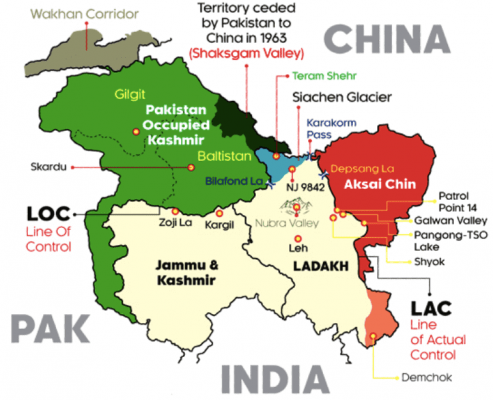- Home
- Prelims
- Mains
- Current Affairs
- Study Materials
- Test Series
COK - Chinese-Occupied Kashmir - What have we forgotten?.
Following the abrogation of Article 370 and reorganisation of the Indian State of Jammu and Kashmir (J&K), a China-Pakistan tandem has emerged to internationalise the issue, including in the UN Security Council. China’s support for Pakistan is motivated by a desire to perpetuate its own territorial grab in the trans-Karakoram Shaksgam Tract of Kashmir.
 The doublespeak of China
The doublespeak of China
 The doublespeak of China
The doublespeak of China
- China treats the J&K issue as a “bilateral dispute left over from history” to be resolved between India and Pakistan. It has turned a blind eye to the constitutional shenanigans by which Pakistan’s so-called federal Ministry of Kashmir Affairs and Gilgit-Baltistan has acquired complete sway over Pakistan Occupied Kashmir (PoK).
- It ignores Pakistan’s agenda of integrating Gilgit-Baltistan as its fifth province. Yet, China has the temerity to question the establishment of the Union Territory of Ladakh and to term it a ‘unilateral’ attempt to change “the status quo in the Kashmir region”.
- The Shaksgam valley in the trans-Karakoram tract, part of PoK, was handed over on a platter by a supine Pakistan to China through an illegal border agreement on March 2, 1963. However, the continuing Chinese occupation of Kashmir’s territory does not find adequate mention in the contemporary discourse surrounding this issue.
- China occupies 5,180 square kilometres in the Shaksgam Valley in addition to approximately 38,000 square kilometres in Aksai Chin. China and Pakistan have colluded to obfuscate these facts, even as they brazenly promote the China-Pakistan Economic Corridor (CPEC) which runs through parts of Indian territory under their respective occupation.
- Historically, China played an insidious role in changing the frontiers of Jammu and Kashmir through fictitious claims and unscrupulous alliances with local chieftains. China exploited the ‘Great Game’ between British India and Russia in the late 19th century. It pitched territorial claims far beyond the traditional frontiers of Xinjiang. It gradually crept into areas in the Taghdumbash Pamirs and the Karakorams, well south of its frontier along the Kun Lun mountains.
- While the British and the Russians were busy creating buffer zones along the frontiers of Xinjiang and Tibet, China was systematically stepping into the void. By the 1890s, China had started asserting its presence in the valleys between the Kun Lun and the main Karakoram range.
- The British eroded the traditional frontiers of the Maharaja of Kashmir in the region around Shahidullah and also those of his vassal, the Mir of Hunza. After the Mir’s defeat in 1869 at the hands of the joint forces of the Maharaja and the British, the Chinese tried to co-opt him in their scheme while giving him refuge.
- Till then, the Mir’s authority, ranging in the Taghdumbash Pamirs till Dafdar and eastward in Raskam, had never been contested by the Chinese. The Chinese had started the practice of exchanging annual presents with the Mir of Hunza in recognition of his authority over the unruly nomadic tribes that inhabited these valleys. The tradition of exchanging gifts with the Mir of Hunza was exploited to stake a retrospective claim to Hunza as a tributary of the Qing empire since 1762 AD. This chicanery is contradicted by China’s own historical accounts and maps of the 18th and the 19th centuries which show the south-western frontiers of China extending barely up to the Kun Lun range.
- By 1891, the Chinese had quietly moved south of the Kun Lun range to consolidate their presence at Shahidullah, which earlier marked the furthest outpost of the princely state of J&K. They then moved further south to Suget, and thereafter, showed up at the Karakoram pass. In 1936, the Mir of Hunza was asked by the British to abandon his rights in the Taghdumbash Pamirs as well as in the Raskam valley, but the Shaksgam valley to the south-west of Raskam and the Aghil range remained with the Mir of Hunza. This remained the traditional frontier of British India until independence, inherited by India following J&K’s accession in 1947.
- It is this border that was blatantly compromised by Pakistan in its so-called agreement with China on March 2, 1963. By giving in to China’s expansionist designs and spurious claims to a boundary along the Karakoram range, Pakistan not only compromised India’s traditional frontier along the Kun Lun range to the north-west of the Karakoram Pass, but also enabled China to extrapolate a claim line eastwards along the Karakoram range in Ladakh.
- This collusion allowed China to claim the whole of Aksai Chin in which it had no historical presence. After the Partition of the Indian subcontinent, from 1953, Chinese troops actively started transgressing the frontier in eastern Hunza. In October 1959, they rustled some livestock from the area, prompting an angry response from Pakistan that it was determined to defend its frontiers.
- However, President Ayub Khan, spotting an opportunity in the rapidly deteriorating India-China ties in the late 1950s, decided, instead, to pander to the Chinese. Pakistan deliberately chose to downgrade the historical claims of the Mir of Hunza and eventually signed away the Shaksgam valley to China in 1963.









 Latest News
Latest News
 General Studies
General Studies